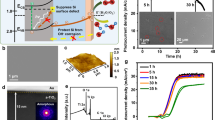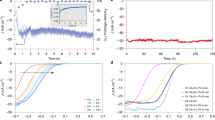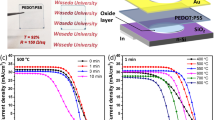Abstract
Black silicon (b-Si) is a surface-nanostructured Si with extremely efficient light absorption capability and is therefore of interest for solar energy conversion. However, intense charge recombination and low electrochemical stability limit the use of b-Si in photoelectrochemical solar-fuel production. Here we report that a conformal, ultrathin, amorphous TiO2 film deposited by low-temperature atomic layer deposition (ALD) on top of b-Si can simultaneously address both of these issues. Combined with a Co(OH)2 thin film as the oxygen evolution catalyst, this b-Si/TiO2/Co(OH)2 heterostructured photoanode was able to produce a saturated photocurrent density of 32.3 mA cm−2 at an external potential of 1.48 V versus reversible reference electrode (RHE) in 1 M NaOH electrolyte. The enhanced photocurrent relative to planar Si and unprotected b-Si photoelectrodes was attributed to the enhanced charge separation efficiency as a result of the effective passivation of defective sites on the b-Si surface. The 8-nm ALD TiO2 layer extends the operational lifetime of b-Si from less than half an hour to four hours.
This is a preview of subscription content, access via your institution
Access options
Access Nature and 54 other Nature Portfolio journals
Get Nature+, our best-value online-access subscription
$29.99 / 30 days
cancel any time
Subscribe to this journal
Receive 12 digital issues and online access to articles
$119.00 per year
only $9.92 per issue
Buy this article
- Purchase on Springer Link
- Instant access to full article PDF
Prices may be subject to local taxes which are calculated during checkout




Similar content being viewed by others
References
Lewis, N. S. Research opportunities to advance solar energy utilization. Science 351, 1920 (2016).
Khaselev, O. & Turner, J. A. Monolithic photovoltaic-photoelectrochemical device for hydrogen production via water splitting. Science 280, 425–427 (1998).
Walter, M. G. et al. Solar water splitting cells. Chem. Rev. 110, 6446–6473 (2010).
Joya, K. S., Joya, Y. F., Ocakoglu, K. & van de Krol, R. Water-splitting catalysis and solar fuel devices: artificial leaves on the move. Angew. Chem. Int. Ed. 52, 10426–10437 (2013).
Kenney, M. J. et al. High-performance silicon photoanodes passivated with ultrathin nickel films for water oxidation. Science 342, 836–840 (2013).
Liu, C., Colon, B. C., Ziesack, M., Silver, P. A. & Nocera, D. G. Water splitting-biosynthetic system with CO2 reduction efficiencies exceeding photosynthesis. Science 352, 1210–1213 (2016).
Wang, G. et al. Hydrogen-treated TiO2 nanowire arrays for photoelectrochemical water splitting. Nano Lett. 11, 3026–3033 (2011).
Warren, S. C. et al. Identifying champion nanostructures for solar water-splitting. Nat. Mater. 12, 842–849 (2013).
Kim, T. W. & Choi, K. S. Nanoporous BiVO4 photoanodes with dual-layer oxygen evolution catalysts for solar water splitting. Science 343, 990–994 (2014).
Huang, Z., Geyer, N., Werner, P., de Boor, J. & Gosele, U. Metal-assisted chemical etching of silicon: a review. Adv. Mater. 23, 285–308 (2011).
Yuan, G. et al. Understanding the origin of the low performance of chemically grown silicon nanowires for solar energy conversion. Angew. Chem. Int. Ed. 50, 2334–2338 (2011).
Oh, J., Deutsch, T. G., Yuan, H.-C. & Branz, H. M. Nanoporous black silicon photocathode for H2 production by photoelectrochemical water splitting. Energy Environ. Sci. 4, 1690–1694 (2011).
Zhao, Y. et al. Oxidatively stable nanoporous silicon photocathodes with enhanced onset voltage for photoelectrochemical proton reduction. Nano Lett. 15, 2517–2525 (2015).
Ali, M. et al. Nanostructured photoelectrochemical solar cell for nitrogen reduction using plasmon-enhanced black silicon. Nat. Commun. 7, 11335 (2016).
Oh, J., Yuan, H. C. & Branz, H. M. An 18.2%-efficient black-silicon solar cell achieved through control of carrier recombination in nanostructures. Nat. Nanotech. 7, 743–748 (2012).
Savin, H. et al. Black silicon solar cells with interdigitated back-contacts achieve 22.1% efficiency. Nat. Nanotech. 10, 624–628 (2015).
Chen, Y. W. et al. Atomic layer-deposited tunnel oxide stabilizes silicon photoanodes for water oxidation. Nat. Mater. 10, 539–544 (2011).
Chen, L. et al. p-type transparent conducting oxide/n-type semiconductor heterojunctions for efficient and stable solar water oxidation. J. Am. Chem. Soc. 137, 9595–9603 (2015).
Ji, L. et al. A silicon-based photocathode for water reduction with an epitaxial SrTiO3 protection layer and a nanostructured catalyst. Nat. Nanotech. 10, 84–90 (2015).
Sun, K. et al. Stable solar-driven oxidation of water by semiconducting photoanodes protected by transparent catalytic nickel oxide films. Proc. Natl Acad. Sci. USA 112, 3612–3617 (2015).
Wang, W. C. et al. Surface passivation of efficient nanotextured black silicon solar cells using thermal atomic layer deposition. ACS Appl. Mater. Interfaces 5, 9752–9759 (2013).
Wang, W. C., Tsai, M. C., Yang, J., Hsu, C. & Chen, M. J. Efficiency enhancement of nanotextured black silicon solar cells using Al2O3/TiO2 dual-layer passivation stack prepared by atomic layer deposition. ACS Appl. Mater. Interfaces 7, 10228–10237 (2015).
Hu, S. et al. Amorphous TiO2 coatings stabilize Si, GaAs, and GaP photoanodes for efficient water oxidation. Science 344, 1005–1009 (2014).
Gu, J. et al. Water reduction by a p-GaInP2 photoelectrode stabilized by an amorphous TiO2 coating and a molecular cobalt catalyst. Nat. Mater. 15, 456–460 (2016).
Qiu, J. et al. Microscopic study of atomic layer deposition of TiO2 on GaAs and its photocatalytic application. Chem. Mater. 27, 7977–7981 (2015).
Shaner, M. R., Hu, S., Sun, K. & Lewis, N. S. Stabilization of Si microwire arrays for solar-driven H2O oxidation to O2(g) in 1.0 M KOH(aq) using conformal coatings of amorphous TiO2 . Energy Environ. Sci. 8, 203–207 (2015).
Lee, C. Y., Park, H. S., Fontecilla-Camps, J. C. & Reisner, E. Photoelectrochemical H2 evolution with a hydrogenase immobilized on a TiO2-protected silicon electrode. Angew. Chem. Int. Ed. 55, 5971–5974 (2016).
Hill, J. C., Landers, A. T. & Switzer, J. A. An electrodeposited inhomogeneous metal–insulator–semiconductor junction for efficient photoelectrochemical water oxidation. Nat. Mater. 14, 1150–1155 (2015).
Ng, J. W. D. et al. Gold-supported cerium-doped NiOx catalysts for water oxidation. Nat. Energy 1, 16053 (2016).
Feng, J. X. et al. Co(OH)2@PANI hybrid nanosheets with 3D networks as high-performance electrocatalysts for hydrogen evolution reaction. Adv. Mater. 27, 7051–7057 (2015).
Yang, J. et al. A multifunctional biphasic water splitting catalyst tailored for integration with high-performance semiconductor photoanodes. Nat. Mater. 16, 335–341 (2017).
Yang, J. et al. Efficient and sustained photoelectrochemical water oxidation by cobalt oxide/silicon photoanodes with nanotextured interfaces. J. Am. Chem. Soc. 136, 6191–6194 (2014).
Lin, F. & Boettcher, S. W. Adaptive semiconductor/electrocatalyst junctions in water-splitting photoanodes. Nat. Mater. 13, 81–86 (2014).
Laskowski, F. L., Nellist, M. R., Venkatkarthickab, R. & Boettcher, S. W. Junction behavior of n-Si photoanodes protected by thin Ni elucidated from dual working electrode photoelectrochemistry. Energy Environ. Sci. 10, 570–579 (2017).
Sun, K. et al. Stable solar-driven water oxidation to O2(g) by Ni-oxide-coated silicon photoanodes. J. Phys. Chem. Lett. 6, 592–598 (2015).
Caban-Acevedo, M. et al. Efficient hydrogen evolution catalysis using ternary pyrite-type cobalt phosphosulphide. Nat. Mater. 14, 1245–1251 (2015).
Garnett, E. & Yang, P. Light trapping in silicon nanowire solar cells. Nano Lett. 10, 1082–1087 (2010).
Branz, H. M. et al. Nanostructured black silicon and the optical reflectance of graded-density surfaces. Appl. Phys. Lett. 94, 231121 (2009).
Yang, W. et al. Ferroelectric polarization-enhanced photoelectrochemical water splitting in TiO2-BaTiO3 core-shell nanowire photoanodes. Nano Lett. 15, 7574–7580 (2015).
Yu, Y., Yin, X., Kvit, A. & Wang, X. Evolution of hollow TiO2 nanostructures via the Kirkendall effect driven by cation exchange with enhanced photoelectrochemical performance. Nano Lett. 14, 2528–2535 (2014).
Yu, Y. et al. Development of lead iodide perovskite solar cells using three-dimensional titanium dioxide nanowire architectures. ACS Nano 9, 564–572 (2015).
Acknowledgements
Work on ALD-based growth and structure characterization is supported by US Department of Energy (DOE), Office of Science, Basic Energy Sciences (BES), under Award # DE-SC0008711. The rest of the work is supported by the National Major Research Program of China (No. 2013CB932602); the Program of Introducing Talents of Discipline to Universities (B14003); National Natural Science Foundation of China (No. 51527802, 51232001, 51602020 and 51672026); and Beijing Municipal Science & Technology Commission.
Author information
Authors and Affiliations
Contributions
Y.Y., Y.Z. and X.W. conceived the ideas, designed the experiments and oversaw the entire project. Y.Y. and Z.Z. performed the device fabrication, electrochemical measurements and data analysis. Y.Y. Q.L., Z.K. and X.Yan conducted the SEM, XPS and XRD characterizations. Y.Y., X.Yin and A.K. carried out the TEM, STEM and EELS mappings. Y.Y., Z.Z., Y.Z. and X.W. wrote the manuscript. All authors discussed the experiments and commented on the manuscript.
Corresponding authors
Ethics declarations
Competing interests
The authors declare no competing financial interests.
Supplementary information
Supplementary Information
Supplementary Figures 1–16. (PDF 1810 kb)
Rights and permissions
About this article
Cite this article
Yu, Y., Zhang, Z., Yin, X. et al. Enhanced photoelectrochemical efficiency and stability using a conformal TiO2 film on a black silicon photoanode. Nat Energy 2, 17045 (2017). https://doi.org/10.1038/nenergy.2017.45
Received:
Accepted:
Published:
DOI: https://doi.org/10.1038/nenergy.2017.45
This article is cited by
-
Atomically dispersed iridium catalysts on silicon photoanode for efficient photoelectrochemical water splitting
Nature Communications (2023)
-
Substantial lifetime enhancement for Si-based photoanodes enabled by amorphous TiO2 coating with improved stoichiometry
Nature Communications (2023)
-
Recent Advancements in Photoelectrochemical Water Splitting for Hydrogen Production
Electrochemical Energy Reviews (2023)
-
Back-illuminated photoelectrochemical flow cell for efficient CO2 reduction
Nature Communications (2022)
-
Hydrogen-substituted graphdiyne encapsulated cuprous oxide photocathode for efficient and stable photoelectrochemical water reduction
Nature Communications (2022)



